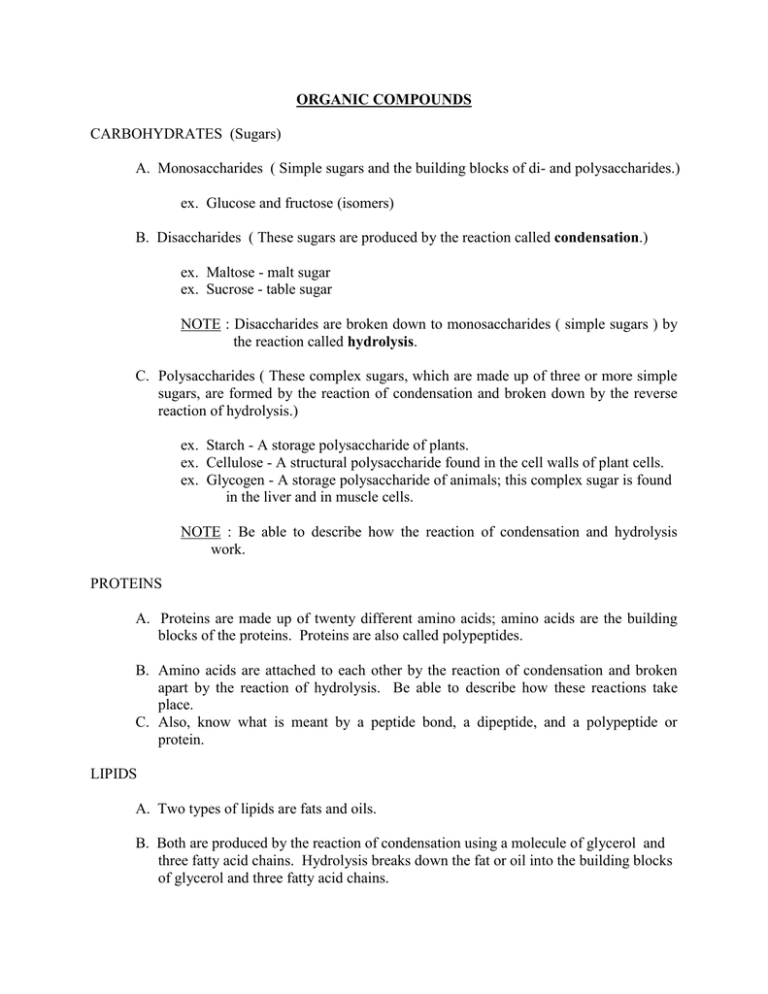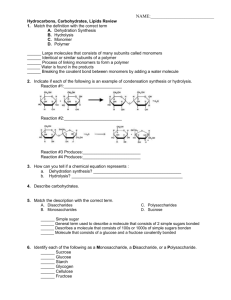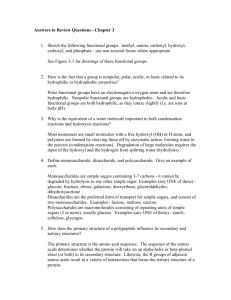ORGANIC COMPOUNDS ex. Glucose and fructose (isomers)
advertisement

ORGANIC COMPOUNDS CARBOHYDRATES (Sugars) A. Monosaccharides ( Simple sugars and the building blocks of di- and polysaccharides.) ex. Glucose and fructose (isomers) B. Disaccharides ( These sugars are produced by the reaction called condensation.) ex. Maltose - malt sugar ex. Sucrose - table sugar NOTE : Disaccharides are broken down to monosaccharides ( simple sugars ) by the reaction called hydrolysis. C. Polysaccharides ( These complex sugars, which are made up of three or more simple sugars, are formed by the reaction of condensation and broken down by the reverse reaction of hydrolysis.) ex. Starch - A storage polysaccharide of plants. ex. Cellulose - A structural polysaccharide found in the cell walls of plant cells. ex. Glycogen - A storage polysaccharide of animals; this complex sugar is found in the liver and in muscle cells. NOTE : Be able to describe how the reaction of condensation and hydrolysis work. PROTEINS A. Proteins are made up of twenty different amino acids; amino acids are the building blocks of the proteins. Proteins are also called polypeptides. B. Amino acids are attached to each other by the reaction of condensation and broken apart by the reaction of hydrolysis. Be able to describe how these reactions take place. C. Also, know what is meant by a peptide bond, a dipeptide, and a polypeptide or protein. LIPIDS A. Two types of lipids are fats and oils. B. Both are produced by the reaction of condensation using a molecule of glycerol and three fatty acid chains. Hydrolysis breaks down the fat or oil into the building blocks of glycerol and three fatty acid chains. C. A saturated fatty acid is one that contains as much of the element hydrogen as it can possibly hold. In a saturated fatty acid there are only single bonds holding the carbon atoms together in the fatty acid chain. D. An unsaturated fatty acid is one that does not contain as much hydrogen as it can possibly hold. In an unsaturated fatty acid there are one or more double bonds holding the carbon atoms together in the fatty acid chain. E. In general, fats are made up of glycerol and saturated fatty acid chains while oils are made up of glycerol and unsaturated fatty acid chains. Fats are solid at room temperature while oils are liquid. Fats are derived form animals while oils come from plants.




